This introductory blog serves as a comprehensive level-set for the entire Southwestern Medical District Transformation Project. It offers a full overview of the vision, context, and foundational strategies behind this ambitious initiative. Future blog posts will be shorter in length and will dive more deeply into specific, unique aspects of the project—such as our community engagement process, evidence-based design practices, biophilic principles, and public-private funding, and more. Thank you for exploring the big picture with us in this launch edition.
A District Defined by Purpose and Possibility
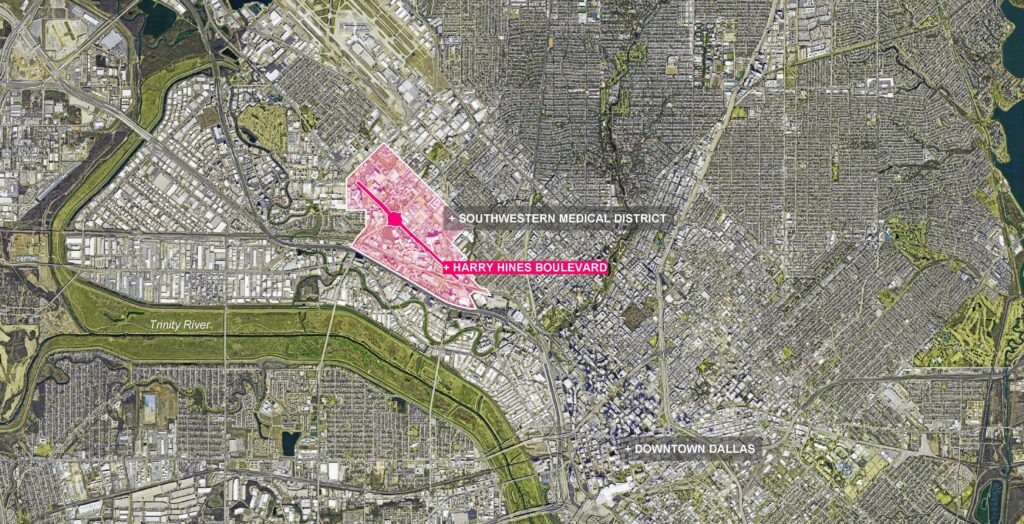
The Southwestern Medical District (Medical District or SWMD for short) in Dallas, Texas, thrives on the vitality and contributions of its unique community, encompassing medical professionals, patients, students, residents, business owners, and visitors. With 8.4 million Dallas-Fort Worth residents, and growing, the Southwestern Medical District is an invaluable asset to our region, delivering renowned health care in partnership with innovative, world-class research and education.
The Medical District is a bustling community of contrast. It is home to remarkable, award-winning medical institutions whose workforce fulfills routine and critical medical needs, cares for every stage of life and population, and advances medical discoveries and innovation. However, step outside of the four walls of the hospital facilities, and into the streetscape, and a less vibrant story emerges.

A Landscape for Health and Healing: The SWMD Transformation Project
Led by the Texas Trees Foundation (Texas Trees, for short), the Southwestern Urban Streetscape and Park Transformation Project is an ambitious effort to create a cooler, cleaner, greener, safer, and more connected medical district in Dallas by revitalizing a 2-mile stretch of the Harry Hines Corridor and building an 8-acre park that promotes health, healing, and well-being.
Texas Trees has been dedicated to improving the health of cities and people through the transformative power of trees for over 40 years. We believe that as a nonprofit organization, our mission, values, ability to ask tough questions, and “dig deeper” to tackle complex, interwoven challenges, have uniquely equipped us to lead the charge on the Southwestern Medical District Transformation Project.
In 2015, we launched the State of the Dallas Urban Forest Report and in 2017, we published the Urban Heat Island Management Study. These reports identified the Southwestern Medical District as one of the largest urban heat islands in the City of Dallas and severely deficient of tree canopy.
Equipped with compelling data and a clear understanding of the challenges facing the district and their impact on human health, we knew action was imperative, and that meaningful, lasting change would require an innovative, collaborative approach. In 2016, the Southwestern Medical District Transformation Project was officially launched, marking a pivotal moment as public agencies and private philanthropies joined forces with the Texas Trees Foundation to drive transformational change.
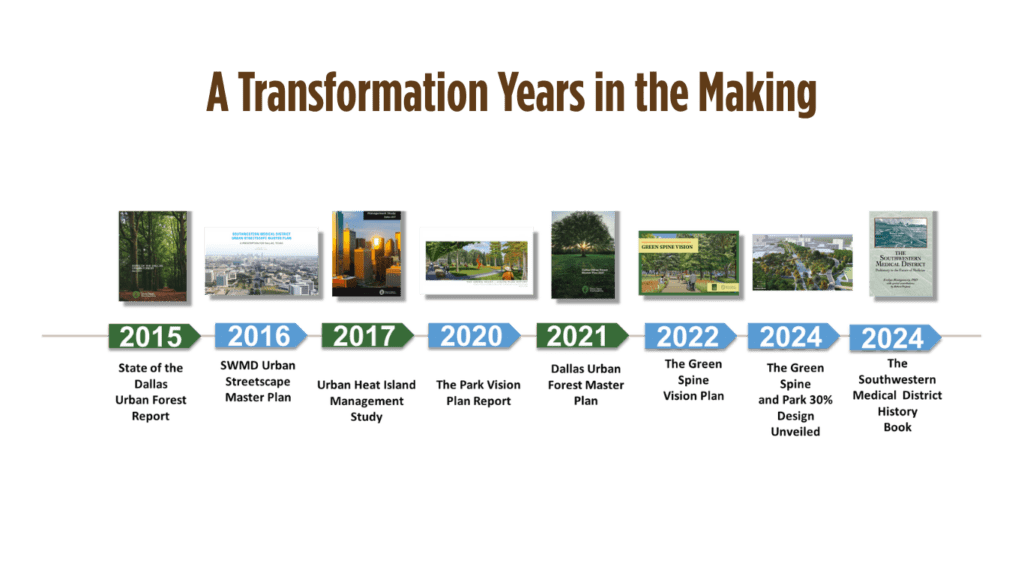
Our Project Framework: An Approach at the Intersection of Health and Nature
The genesis of the SWMD project was rooted in improving environmental conditions to positively impact human health for all SWMD community members because they are the lifeblood of the District.
Our desire is for the transformation to be holistic in its approach, positively impacting the community’s quality of life by re-integrating nature within the urban ecosystem of the Southwestern Medical District. We do not want this project to be characterized by only aesthetic enhancements, but rather, for it to be significant and relevant to those for whom it is designed, and for its effects to be resilient and long-lasting.
To achieve this, we stepped back to examine the broader framework necessary to address the district’s complex challenges. The team developed a structure anchored in three foundational design strategies: an evidence-based design process, the integration of biophilic design principles, and a commitment to the One Health approach. These strategies are further guided by five project pillars that ensure the initiative remains aligned with the shared mission, values, and goals of the Texas Trees Foundation, our partners, donors, and the Medical District community. Finally, meaningful community engagement encompasses all of this, ensuring that designing for the unique Southwestern Medical District community is a principle constantly guiding our work.
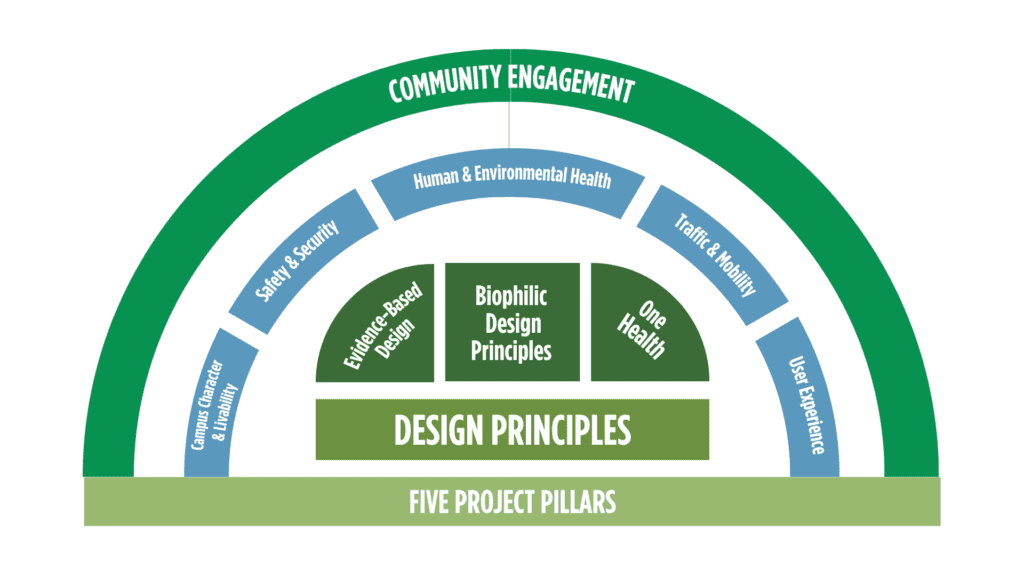
Evidence-Based Design
We know that healthy environments can influence healthy outcomes. To accomplish this, we are employing an evidence-based design (EBD) strategy, an approach that integrates the best available research with design expertise. EBD ensures that each design decision – from small to large – is grounded in credible scientific evidence to measure projected impact on human and environmental health. In particular, the variables that our project is seeking to have an impact on include metrics of heat, air quality, and biodiversity.
In practice, our EBD strategy takes the form of measuring real-time microclimatic environmental conditions, modeling a “digital twin” version of the Medical District’s terrain, buildings, and vegetation, and using these variables to test multiple scenarios, or design modifications, to identify the most effective design interventions at the most strategic locations.
This evidence-based design work is the first pilot project across the United States done at this scale and scope. We’re hoping that this process can set a new standard for designing healthy environments and serve as a model for other projects seeking to make a similar positive impact. Thank you to our partners at Hyphae Design Laboratory and Field Operations for their innovative expertise and synergy which are essential to our EBD approach.
[Want to learn more? We want to share more! We will go into more detail on our Evidence-Based Design Strategy in our July blog edition].
Biophilic Design Principles
Too often, the integral role that nature plays in health and wellbeing is not paid due attention to in the architectural and design fields. Biophilic design offers a powerful, applied solution to our innate desire for connection with nature by seamlessly integrating natural elements and processes into the built environment, re-establishing the natural harmony between people and nature.
Our partners at Terrapin Bright Green (TBG) created the pioneering ‘15 Patterns of Biophilic Design Framework' which outlines the fifteen distinct ways you can implement biophilia in design, and the associated positive health outcomes for each -- ranging from aspects of stress reduction, improved cognition, and mood enhancement.
TBG has provided invaluable guidance since the onset of our project’s design, equipping our team with a deeper understanding of how to intentionally apply biophilic design principles as an integrated strategy capable of influencing how people feel, heal, and connect. While planting trees and adding green spaces are essential, biophilic design takes it a step further -- involving thoughtful integration of natural patterns, sensory variability, spatial complexity, and thermal comfort -- all of which contribute to physical and emotional well-being.
To date, ten of the fifteen patterns of biophilic design are visibly embedded in our design plans, reinforcing our commitment to create a Medical District that supports healing, resilience, and a positive daily human experience. Visit our biophilia infographic to explore how each pattern is expressed in the project and the specific health outcomes it supports.
[Want to learn more? We want to share more! We will go into more detail on our Biophilia in our October blog edition].
Designing for One Health
By original definition, one health is an approach that recognizes that the health of people is closely connected to the health of animals and our shared environment.
Our project team is similarly inspired by the critical role that one’s physical environment has in influencing the myriads of aspects that comprise human health and well-being. We reimagined this concept as a framework for designing a public space that achieves a truly “healthy environment”, by creating opportunities for rest, contemplation, movement and socialization.
You will see one health reflected in the project’s design through features such as the two-way cycle track and pedestrian paths, vibrant gathering plazas, tranquil garden rooms, and ample green space, to promote holistic health.
Equitable Community Engagement
Equitable Engagement has been the cornerstone of our project. It is defined as cultivating conversations where all people have a direct bridge to express their needs, goals, and desires, and incorporate their voices.
Conducted in two distinct phases to incorporate the community’s perspectives in conjunction with foundational project milestones, our community engagement process has provided opportunities for meaningful participation and consensus-building among the unique SWMD community to define a shared vision for the district’s future through the design of the Green Park and Green Spine.
Encompassing a unique group of medical professionals, staff, and students, patients, residents, business owners, visitors, and more, community engagement activities offered a glimpse into the rich perspectives of the SWMD community, emphasizing the importance of creating an environment that is mutually beneficial for all types of users.
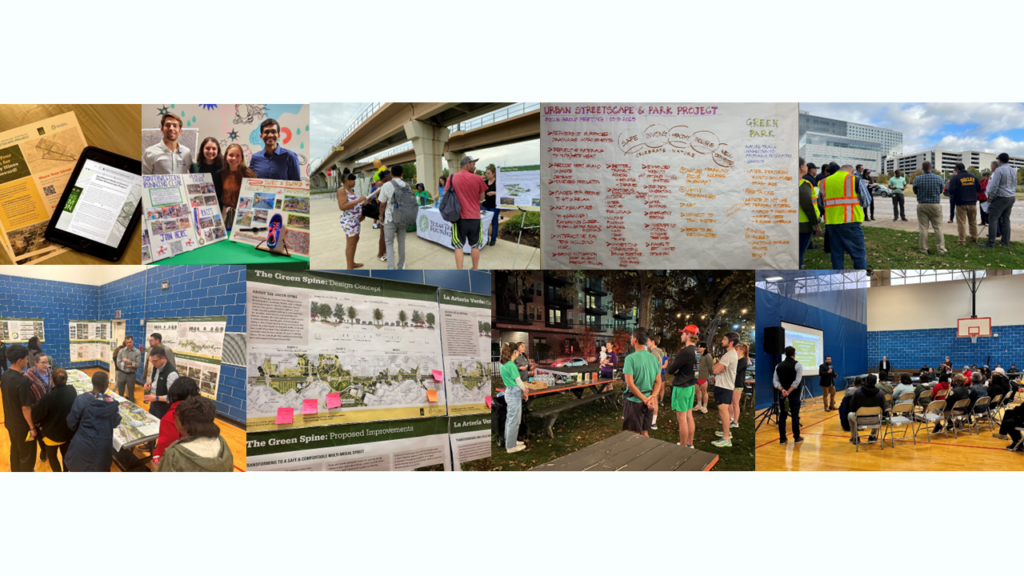
A special shout-out to our partners at MIG, Inc., urban planning and community engagement firm, for leading our community engagement approach, ensuring accessible and meaningful opportunities for the community to be involved in shaping the project’s future each step of the way.
[Want to learn more? Check out our Phase I and Phase II Engagement Summary Reports].
Publishing a History Book on the Southwestern Medical District
In 2020, the team discovered that there was little published research on the history of the Southwestern Medical District, and we had a deep desire to learn more about this area’s past as we began to reimagine its future. Thus, ‘Southwestern Medical District: Prehistory to the Future of Medicine’ was born.
Our team at Texas Trees Foundation commissioned the research and publication of the book by two local historians, author, Dr. Evelyn Montgomery, and special contributor, Robert Prejean.
Through its vivid narrative, the book explores the interwoven themes of history, place, identity, and community throughout the area’s relatively young history. These themes will be reflected in the design of the Streetscape and Park through intentional placemaking and wayfinding strategies. The book’s insights underscore the power of bold, innovative thinking, paralleling the expansive possibilities we envision for the Southwestern Medical District Streetscape and Park Transformation.
You can purchase the book online by visiting this link.
[Want to learn more? We want to share more! We will go into more detail on the process of publishing our history book in our September blog edition].
Partners in the Revival of Nature in Dallas
Of course, we cannot accomplish this transformation alone. We are honored to partner with our local public agencies, North Central Texas Council of Governments, Dallas County, and the City of Dallas, whose expertise has been critical in translating a bold vision into a realized project. Equally vital is the generous support of private donors and philanthropic foundations, whose early investments and belief in the power of nature-based solutions have helped bring this work to life.
The partnership of the Southwestern Medical District, and its three member institutions – UT Southwestern Medical Center, Children’s Health, and Parkland Health, has been instrumental. Ongoing collaboration and communication at every step have ensured that the design for the revitalized Harry Hines Streetscape and Green Park reflects an environment that will be uniquely suitable to the needs and desires of the Medical District community.
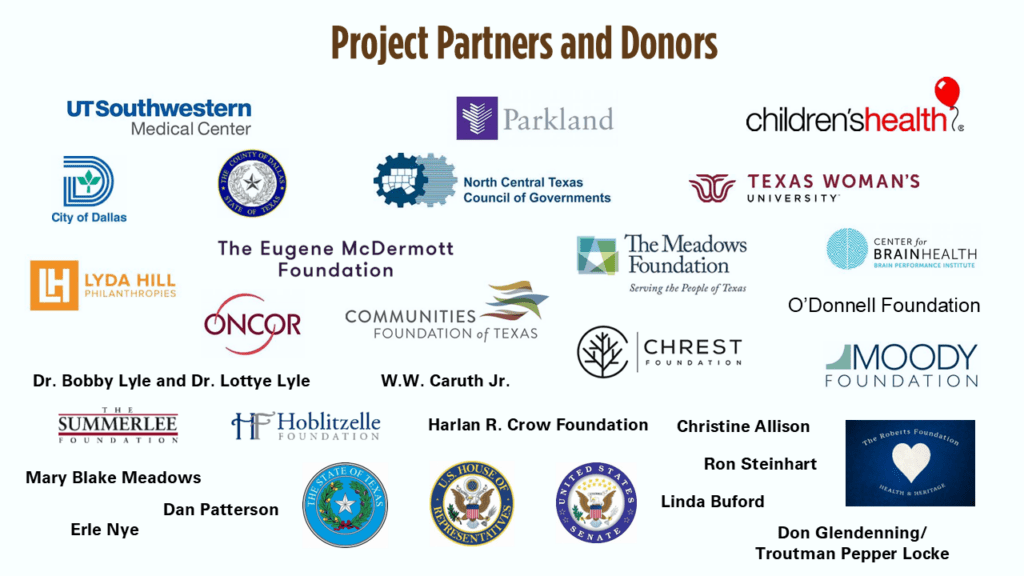
We have carefully assembled a team of experts to come alongside our team at Texas Trees to shape the transformation, with each having enriched the project through innovative approaches and cross-disciplinary collaboration.
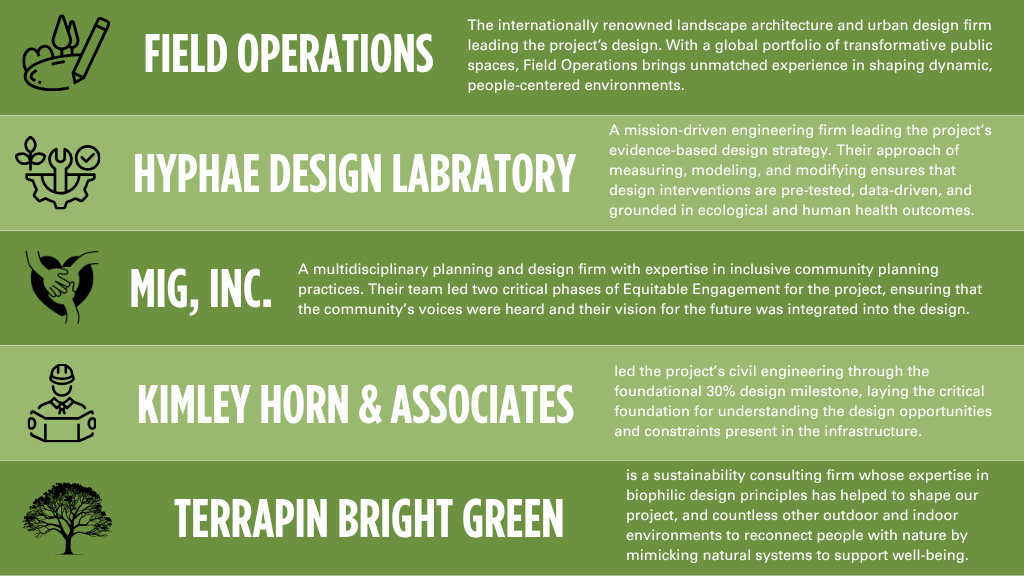
In 2020, we selected accomplished experts across the fields of education and research, environment, economic development, transportation and mobility, and arts and humanities to form the SWMD Transformation Best Practices Advisory Committee. This group convened regularly, engaging in rich dialogue, generating innovative ideas, asking difficult questions, challenging business as normal, and brainstorming solutions. We are indebted to the service of these individuals who have shaped the project as we know it today.
Finally, you can meet our team members at Texas Trees and learn more about our roles on the project by visiting our website.
The Green Spine and the Green Park
The Green Spine: Stitching Together the Southwestern Medical District
Imagine a road that not only serves as a means to get from Point A to Point B but also promotes health and healing along the way. That is exactly what the design for Harry Hines Boulevard, also known as the Green Spine, intends to do.
Harry Hines is the backbone of the Medical District. The road has helped give life to the district, and the growth of the hospital institutions has deliberately followed its path --- with Harry Hines serving as the district’s main arterial corridor, enabling round-the-clock access and connectivity.
Despite its significance, the reality of Harry Hines today is that it is a dangerous, unpleasant, and hot corridor in dire need of upgrades to its aging infrastructure. We have a tremendous opportunity to reimagine Harry Hines as a parkway that truly stitches together the district through walkable, green infrastructure that promotes human and environmental health.
From its northern intersection with Treadway Street to its southern intersection with Lucas Drive, approximately a 2-mile stretch of Harry Hines Blvd. will be completely transformed -- with roadway and utility infrastructure rebuilt, the addition of pedestrian pathways and a two-way cycle track, and a rich, vibrant tree canopy complemented by plants and ornamental grasses.
Graced with a generous amount of public right-of-way, Harry Hines Boulevard’s wide median, currently averaging fifty feet, will be reduced to twenty feet, allowing the reclaimed space to be shifted to each side of the street for pedestrians to enjoy. Although only a few steps away from nearby traffic on Harry Hines, pedestrians will soon find themselves embraced by a rich, natural landscape that protects them from heat, noise pollution, and air pollution, offering a relaxing, pleasant, and safe journey from one destination to the next.
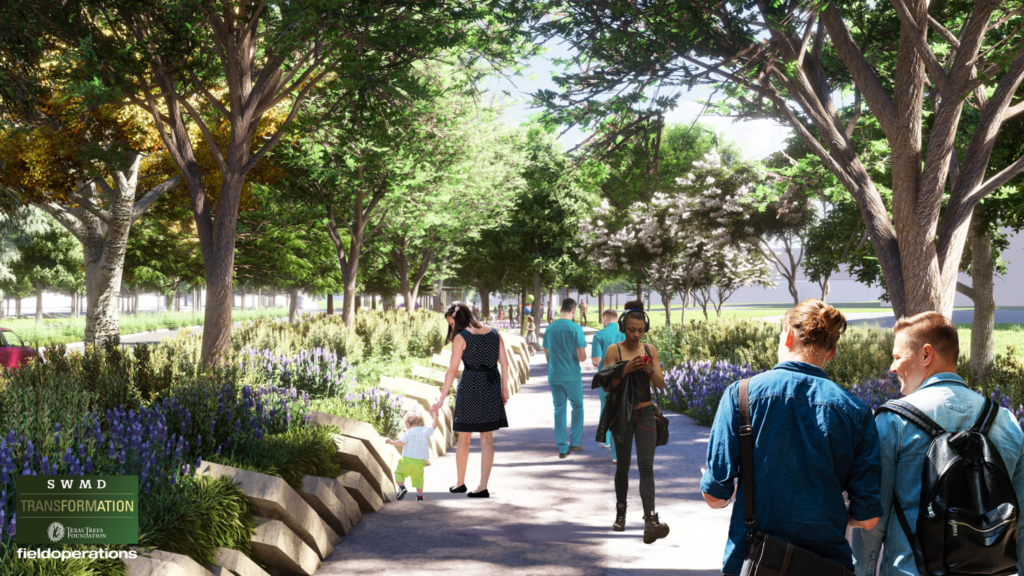
Traffic studies have confirmed that the same number of traffic lanes will remain to ensure continued accessibility for emergency vehicles. Safety enhancements will include SMART Traffic signals, safely designed intersections, and median pedestrian refuges to ensure that users of all ages and abilities can safely cross Harry Hines Blvd.
This reimagination of urban infrastructure asserts the prominent role that the outdoor environment can play in the health and well-being of the people who use the space, and the project seeks to become the new model of a healthy, thriving, and resilient Medical District.
The Green Park: Reclaiming the Heart of the Medical District
The cloverleaf interchange at Harry Hines Boulevard and Inwood Road was built for the sole purpose of managing vehicle traffic transferring between these two major roads. Today, the footprint and functions of the Medical District have expanded far beyond what one could have imagined, and the infrastructure has far surpassed its expected design life.
Today, the cloverleaf interchange design is dangerous to traverse as a driver, and impossible to navigate as a pedestrian. Occupying fourteen acres of land at the heart of the District, the cloverleaf interchange creates a structural and psychological barrier that fragments the community and inhibits connectedness.
The design for the Green Park promises to completely reimagine the function and purpose of the critical Harry Hines-Inwood Road junction. Situated centrally in the Medical District, the intersection is ideally positioned to become an iconic hub for the district. Transformed into eight acres of lush, vibrant green space, the Green Park will be a natural retreat that embraces the Medical District community, creating a setting to re-center, recharge, and reconnect with nature and each other. The Green Park will be a “Prescription for Dallas”; a natural asset just steps away from the hospital institutions that can augment the Medical District’s mission of health, healing, and recovery.
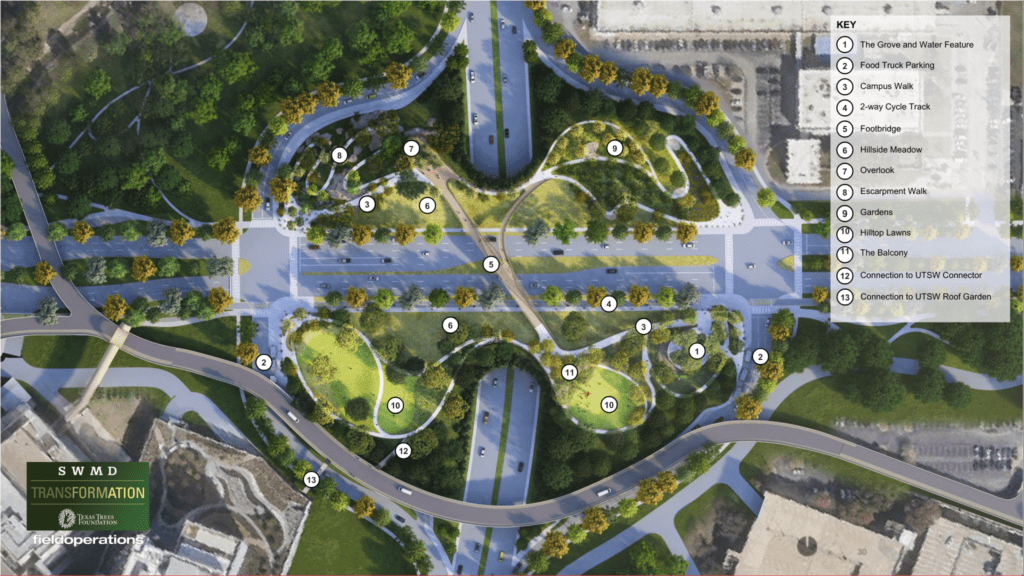
Community engagement findings revealed a clear consensus: the park should serve as a place of tranquility and restoration, rather than one defined by high-energy programming or entertainment. The design reflects this shared vision. In the Green Park, thoughtfully designed landscapes will buffer visitors from the surrounding bustling urban environment, creating an immersive, nature-based setting. The space is envisioned as a refuge-- for patients and families facing health-related hardships; providers who bear the profound responsibility of delivering care, offering hope, and navigating critical outcomes; and for students and researchers who are dedicating themselves to the future of medicine through focused study, innovation and compassion.
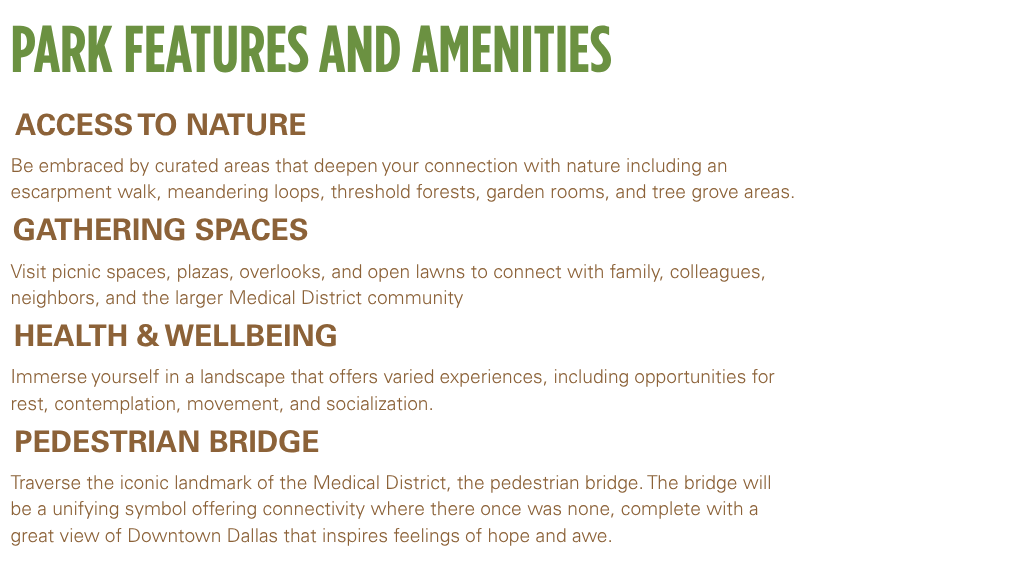
Building the Vision: Timeline, Phasing, and Investment
So when can you expect to experience this transformation for yourself? Good news – Phase 1 of the project is anticipated to go to construction in late 2026 or early 2027.
The project will be constructed in stages, Phase 1, the Green Spine streetscape, and Phase 2, the Green Park, to minimize disruption to the daily operations of the Medical District, steward resources, and devote dedicated focus to each project phase to ensure accurate and efficient delivery of the project’s vision and goals.
The price tag for this project is nothing short of incredible. An ambitious investment of $198 million, this is a once-in-a-generation project poised to yield equally bold returns on measures of human and environmental health, economic impact, and more. The project will be funded by a combination of generous donations from the private philanthropic community and public sector funding all levels. Thus far, we have raised $59 million towards our goal.
The years to come will be marked by hard work to realize a vision that will transform the Southwestern Medical District’s outdoor environment into a landscape for health, healing, and recovery -- one that we hope generations of practitioners, patients, and the greater Dallas community will treasure for years to come.
Please be sure to follow along with us on this exciting journey! Below, you will find a few resources to dig deeper into the project, and ways to stay in touch with our team.
Digging Deeper – Resources to Learn More 🌱
- To follow along with us on social media, contact our team, sign up for our newsletter, and more, check out our linktr.ee.
- To watch the project's Design Unveiling video, click here.
- Browse Texas Trees Foundation's Report and Studies Library
- Purchase 'Southwestern Medical District: Prehistory to the Future of Medicine'
- To learn about the project's projected impact across our 'Healthy Systems, Healthy People, & Healthy Environment' framework, check out the linked infographic.
- To learn more about the project's projected Economic Impact, check out the linked infographic.
- To learn more about our project's projected Public Health and Safety impact, check out the linked infographic.
